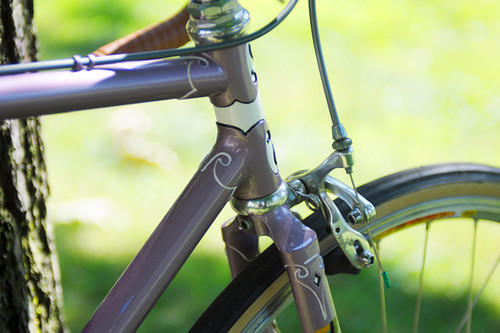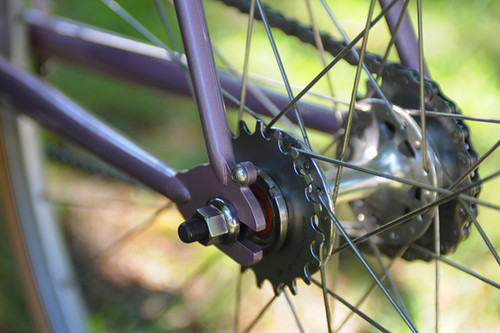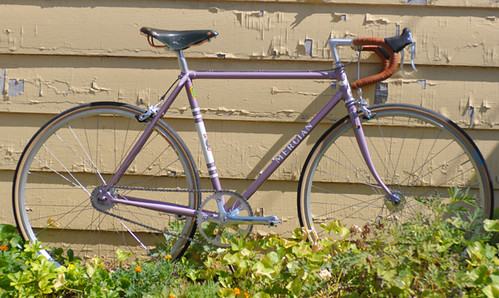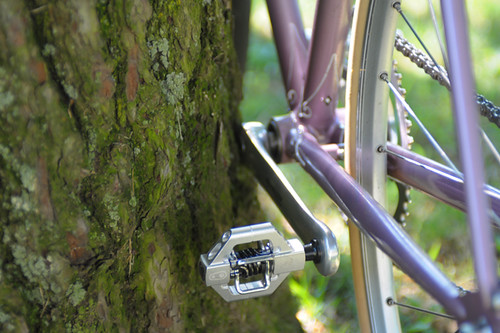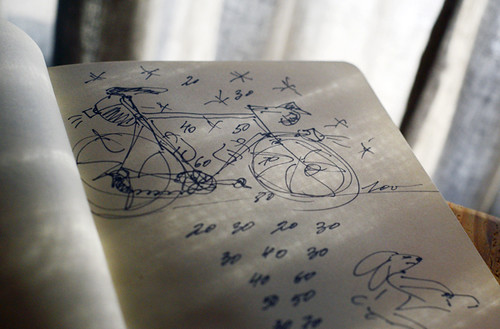
My stay in Vienna is turning out to be very bike-heavy, so to speak, but I am not complaining!
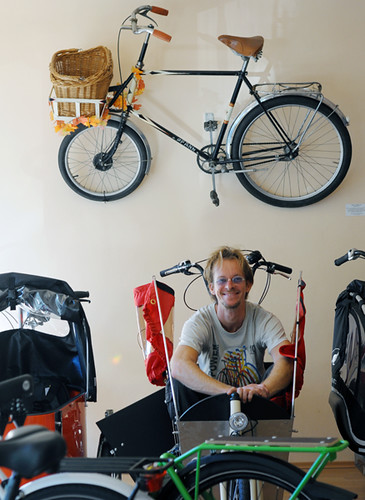
During the year I've been away my friend Wolfgang and his partners have opened up a cargo bike shop, Heavy Pedals, and it's stocked to the gills with the likes of
Bakfiets, Christiania, Larry vs Harry,
Monarch, Winther, Nihola, Yuba Mundo,
XtraCycles and, of course, the inhouse-designed Truck. I can't possibly try them all in the course of this trip, but I was very keen to at least finally try the classic Dutch bakfiets.
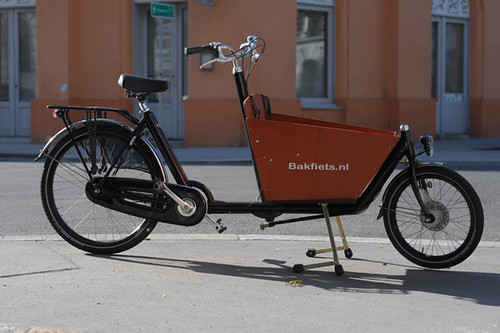
And here it is - so, so beautiful with its elegant lines and shiny wooden box. While I can appreciate modern designs, I remain a sucker for the classic stuff.
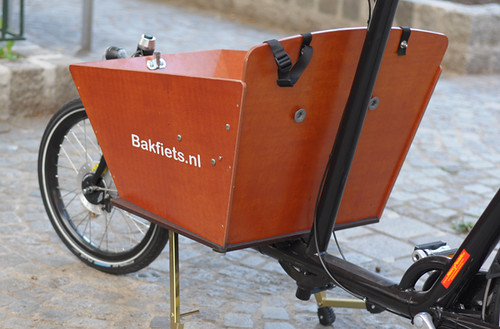
The Bakfiets.nl 2-wheel cargo bikes come in two sizes, and the one I tried is the short version - which, mind you, is still large enough to transport two children. I cannot find the exact weight rating, but it is over 100kg (220lb).
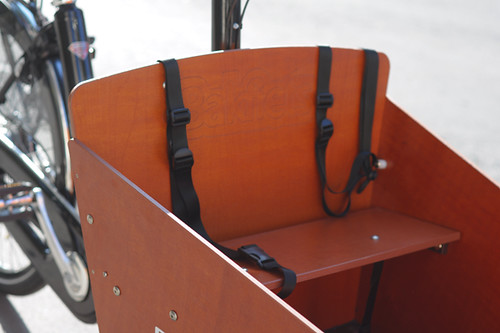
The box includes a folding bench with two sets of seatbelts and optional cushions. This can be removed if you plan to transport cargo and not children.
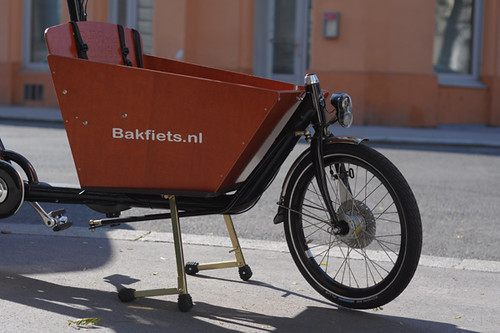
The frame is steel and the complete bike is rather heavy. There is a very sturdy and wide fold-down kickstand that clicks into place when both down and up.
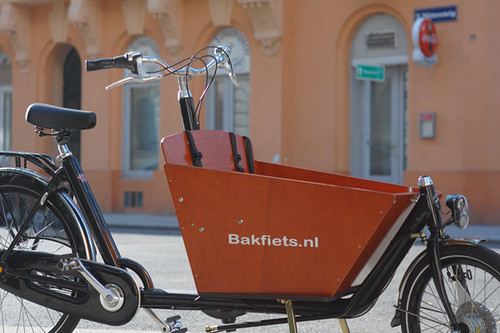
The rear wheel is 26" and the front is 20". It comes equipped with a full chaincase, dress guards, fenders and lighting.

An optional rain cover is fairly easy to attach and remove. A non-human cargo version is also available.
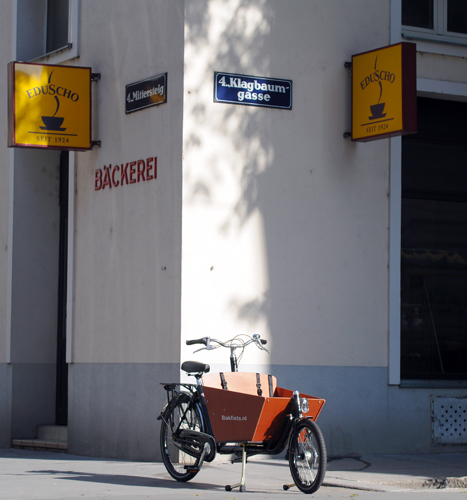
Of all the cargo bikes on the market, my readers are probably most familiar with the classic Dutch bakfiets - meaning, literally, "box bike" - which has been imported into the US for several years now, and has been reviewed by others. The most typical bakfiets is the two wheeler with a wide wooden box in the front, like the one pictured here. It is an old design and several manufacturers make modern-day versions - including the
Bakfiets.nl reviewed here, Workcycles and Babboe. One thing I would like to know is whether these manufacturers order the frames from the same source or make their own, so any insider information is welcome. As others have already written about these bikes at length, I will not go into elaborate detail about their construction and history here, and instead will focus on my impression of the ride quality.

Put simply, I thoroughly enjoyed it. But you are probably looking for something more technical. Okay: Unlike the longtail I tried earlier, the handling of the bakfiets ispeculiar. But the peculiarity is of the ridable variety. As in, you are riding it just fine and thinking "Gee, this feels different" - rather than toppling over because of the difference, as several of us did with the Larry vs Harry Bullitt. If you've ever tried a
Brompton, that's what the bakfiets handling reminded me of the most. The front end is a bit wobbly (with the box empty), but entirely controllable. As Wolfgang put it, it handles like a more extreme version of a classic Dutch bike. Yes.
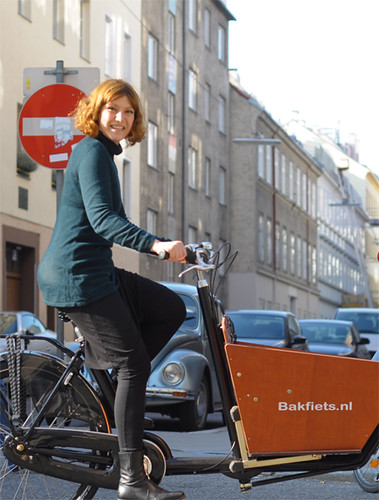
I am not sure why, but of all the cargo bikes I've tried so far, the bakfiets felt especially accessible. You can see in the pictures that I am cycling right on the road. It was actually difficult to photograph me, because cars kept passing from both directions and also from around the corner, ruining all the shots. But I felt pretty comfortable. There was no "learning curve" and by the end of my test ride I was ready to appropriate the bike for my own. This was very different from my experience with Danish longjohns.
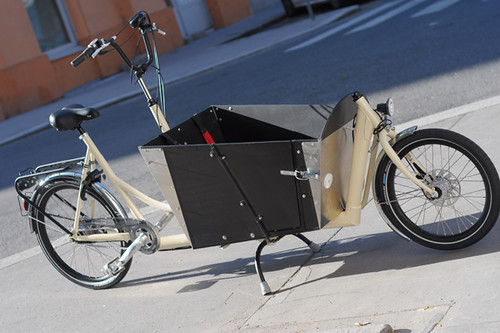
Speaking of Danish, I also briefly tried the
Christiania 2-wheeler. Several months ago, I test rode the three-wheel version, but this is an entirely different kettle of fish. Despite being Danish, this cargo bike resembles a bakfiets rather than a longjohn. In size it is equivalent to the longer version of the bakfiets - large enough to transport 3 children.
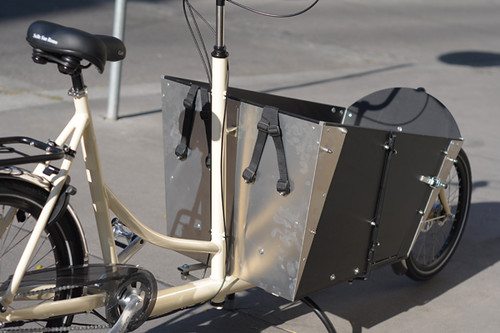
The bicycle is handsome and classic. I am not positive, but the box appears to be part plywood and part metal. Oddly, I can find almost no official information on this bike, even from the Christiania website, despite it technically having been out since . If you can offer additional information, please do.
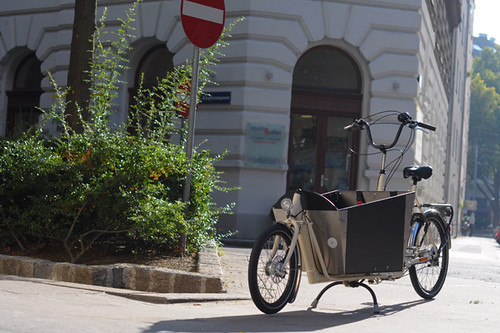
Despite being larger, the
Christianiais lighter than the bakfiets, because the frame is aluminum (as with the 3-wheel version). Both this bike and the bakfiets have welded construction and unicrown forks - as do all cargo bikes I've seen so far - which does not look too bad given their overall utilitarian look. With both bikes, I would generally like to learn more about where and how they are made, but am finding that difficult.
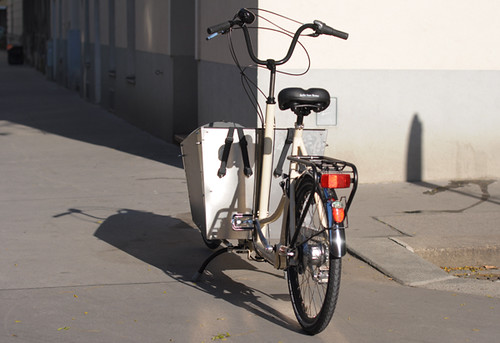
This bike is equipped very similarly to the bakfiets, with an upright sitting position, rear rack, dynamo lighting and several gearing options.Differences in components include the sweep of the handlebars, the kickstand design, the chainguard in leu of full chaincase, and lack of dressguards.
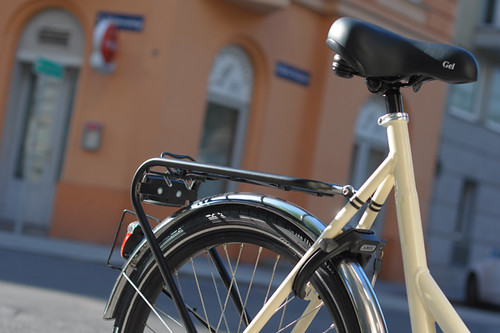
As far as geometry goes, the
Christiania has a somewhat steeper seat tube than the bakfiets. The length of the seat tube is shorter, which means that a smaller person can ride this bike.
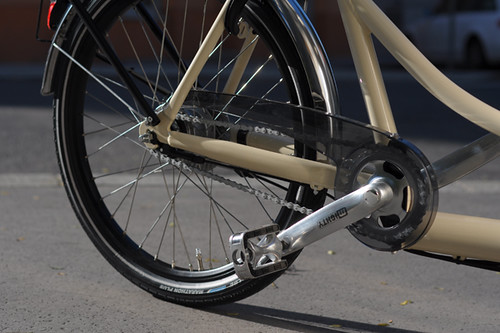
The
Christianiahas a noticeably lower bottom bracket than the bakfiets. And thesweep of the step-through section of the frame is alsodifferent.
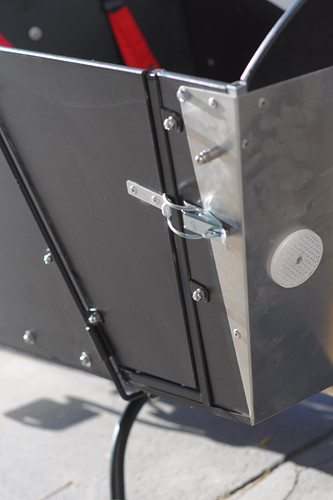
For those who plan to transport children, a very cute and useful feature is the little door in the box with a latch, which the bakfiets lacks. This allows children to walk into the box instead of having to step over the side. A bench with seatbelts is included, just like in the 3-wheel version of the
Christiania.
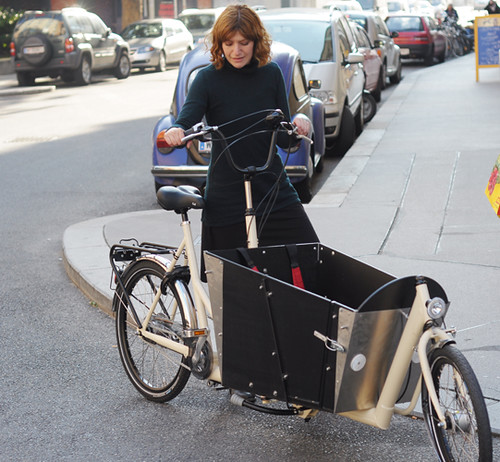
There are no decent photos of me riding the
Christiania, but I did ride it in the same way as the bakfiets. The handling was very similar, though with the
Christiania there was a bit more front-end fishtailing. I assumed that this was due to the front being longer than on the short bakfiets model, but according to Wolfgang this difference exists even compared to the long bakfiets. Nonetheless the bike was entirely rideable and the fishtailing was nothing like what I had experienced on the Bullitt earlier. As with the bakfiets, I could ride the
Christianiaon the first try.
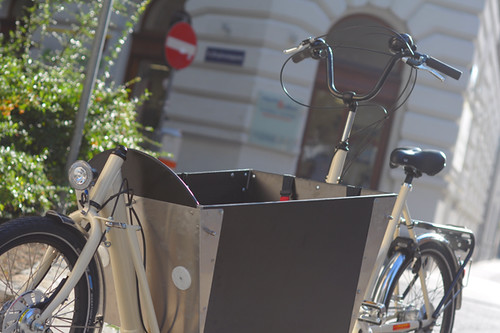
As for how the 2-wheel version compared to the 3-wheeler, they are just entirely different creatures. The 2-wheeler is a bike and handles like a bike, whereas the trike requires you to balance differently and to slow down on corners instead of leaning. As I wrote in my ride report of the trike, I can see myself using it. But overall I prefer the two-wheeler.
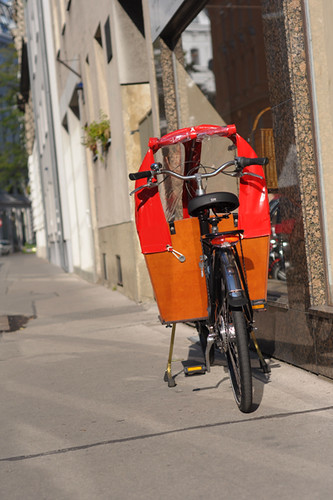
Of the two bikes, I think the short bakfiets is the better choice for me - mainly because the size felt just right, and the handling felt more effortless. Also, the
Christiania, with its little door, seems more oriented toward transporting children, which is not what I would need a cargo bike for. The bakfiets is heavier, but for me that would not matter much in a cargo bike. Of course, your priorities might be different on all accounts.
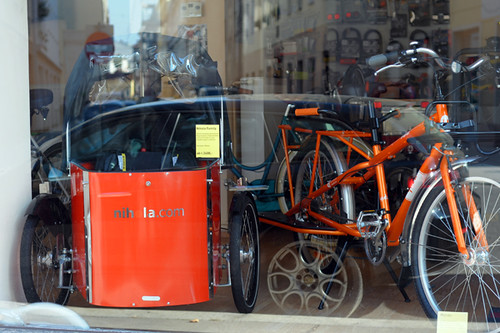
As with my other cargo bike test rides, these were obviously fairly short and should be viewed as "first impressions" rather than in-depth reviews. But I think first impressions matter here, particularly for those trying to determine how ridable various cargo bikes are on the first try for someone who is not already accustomed to them. For me, the
Bakfiets.nl bakfiets and the
Christiania 2-wheeler were quite ridable, despite the unusual handling. Many thanks to Heavy Pedals for the test rides!
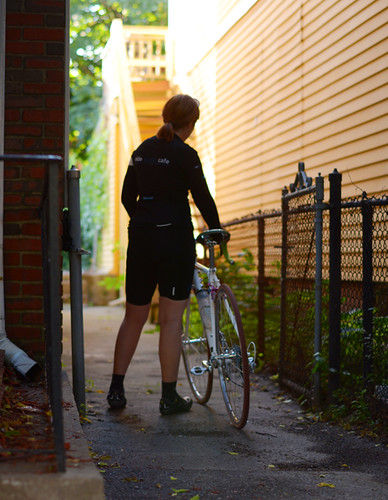






 Dontcha just love the hairdo? What was my mother thinking?
Dontcha just love the hairdo? What was my mother thinking?
 My stay in Vienna is turning out to be very bike-heavy, so to speak, but I am not complaining!
My stay in Vienna is turning out to be very bike-heavy, so to speak, but I am not complaining! During the year I've been away my friend Wolfgang and his partners have opened up a cargo bike shop, Heavy Pedals, and it's stocked to the gills with the likes of Bakfiets, Christiania, Larry vs Harry, Monarch, Winther, Nihola, Yuba Mundo, XtraCycles and, of course, the inhouse-designed Truck. I can't possibly try them all in the course of this trip, but I was very keen to at least finally try the classic Dutch bakfiets.
During the year I've been away my friend Wolfgang and his partners have opened up a cargo bike shop, Heavy Pedals, and it's stocked to the gills with the likes of Bakfiets, Christiania, Larry vs Harry, Monarch, Winther, Nihola, Yuba Mundo, XtraCycles and, of course, the inhouse-designed Truck. I can't possibly try them all in the course of this trip, but I was very keen to at least finally try the classic Dutch bakfiets. And here it is - so, so beautiful with its elegant lines and shiny wooden box. While I can appreciate modern designs, I remain a sucker for the classic stuff.
And here it is - so, so beautiful with its elegant lines and shiny wooden box. While I can appreciate modern designs, I remain a sucker for the classic stuff.  The Bakfiets.nl 2-wheel cargo bikes come in two sizes, and the one I tried is the short version - which, mind you, is still large enough to transport two children. I cannot find the exact weight rating, but it is over 100kg (220lb).
The Bakfiets.nl 2-wheel cargo bikes come in two sizes, and the one I tried is the short version - which, mind you, is still large enough to transport two children. I cannot find the exact weight rating, but it is over 100kg (220lb). The box includes a folding bench with two sets of seatbelts and optional cushions. This can be removed if you plan to transport cargo and not children.
The box includes a folding bench with two sets of seatbelts and optional cushions. This can be removed if you plan to transport cargo and not children. The frame is steel and the complete bike is rather heavy. There is a very sturdy and wide fold-down kickstand that clicks into place when both down and up.
The frame is steel and the complete bike is rather heavy. There is a very sturdy and wide fold-down kickstand that clicks into place when both down and up. The rear wheel is 26" and the front is 20". It comes equipped with a full chaincase, dress guards, fenders and lighting.
The rear wheel is 26" and the front is 20". It comes equipped with a full chaincase, dress guards, fenders and lighting. An optional rain cover is fairly easy to attach and remove. A non-human cargo version is also available.
An optional rain cover is fairly easy to attach and remove. A non-human cargo version is also available. Of all the cargo bikes on the market, my readers are probably most familiar with the classic Dutch bakfiets - meaning, literally, "box bike" - which has been imported into the US for several years now, and has been reviewed by others. The most typical bakfiets is the two wheeler with a wide wooden box in the front, like the one pictured here. It is an old design and several manufacturers make modern-day versions - including the Bakfiets.nl reviewed here, Workcycles and Babboe. One thing I would like to know is whether these manufacturers order the frames from the same source or make their own, so any insider information is welcome. As others have already written about these bikes at length, I will not go into elaborate detail about their construction and history here, and instead will focus on my impression of the ride quality.
Of all the cargo bikes on the market, my readers are probably most familiar with the classic Dutch bakfiets - meaning, literally, "box bike" - which has been imported into the US for several years now, and has been reviewed by others. The most typical bakfiets is the two wheeler with a wide wooden box in the front, like the one pictured here. It is an old design and several manufacturers make modern-day versions - including the Bakfiets.nl reviewed here, Workcycles and Babboe. One thing I would like to know is whether these manufacturers order the frames from the same source or make their own, so any insider information is welcome. As others have already written about these bikes at length, I will not go into elaborate detail about their construction and history here, and instead will focus on my impression of the ride quality. Put simply, I thoroughly enjoyed it. But you are probably looking for something more technical. Okay: Unlike the longtail I tried earlier, the handling of the bakfiets ispeculiar. But the peculiarity is of the ridable variety. As in, you are riding it just fine and thinking "Gee, this feels different" - rather than toppling over because of the difference, as several of us did with the Larry vs Harry Bullitt. If you've ever tried a Brompton, that's what the bakfiets handling reminded me of the most. The front end is a bit wobbly (with the box empty), but entirely controllable. As Wolfgang put it, it handles like a more extreme version of a classic Dutch bike. Yes.
Put simply, I thoroughly enjoyed it. But you are probably looking for something more technical. Okay: Unlike the longtail I tried earlier, the handling of the bakfiets ispeculiar. But the peculiarity is of the ridable variety. As in, you are riding it just fine and thinking "Gee, this feels different" - rather than toppling over because of the difference, as several of us did with the Larry vs Harry Bullitt. If you've ever tried a Brompton, that's what the bakfiets handling reminded me of the most. The front end is a bit wobbly (with the box empty), but entirely controllable. As Wolfgang put it, it handles like a more extreme version of a classic Dutch bike. Yes. I am not sure why, but of all the cargo bikes I've tried so far, the bakfiets felt especially accessible. You can see in the pictures that I am cycling right on the road. It was actually difficult to photograph me, because cars kept passing from both directions and also from around the corner, ruining all the shots. But I felt pretty comfortable. There was no "learning curve" and by the end of my test ride I was ready to appropriate the bike for my own. This was very different from my experience with Danish longjohns.
I am not sure why, but of all the cargo bikes I've tried so far, the bakfiets felt especially accessible. You can see in the pictures that I am cycling right on the road. It was actually difficult to photograph me, because cars kept passing from both directions and also from around the corner, ruining all the shots. But I felt pretty comfortable. There was no "learning curve" and by the end of my test ride I was ready to appropriate the bike for my own. This was very different from my experience with Danish longjohns. Speaking of Danish, I also briefly tried the Christiania 2-wheeler. Several months ago, I test rode the three-wheel version, but this is an entirely different kettle of fish. Despite being Danish, this cargo bike resembles a bakfiets rather than a longjohn. In size it is equivalent to the longer version of the bakfiets - large enough to transport 3 children.
Speaking of Danish, I also briefly tried the Christiania 2-wheeler. Several months ago, I test rode the three-wheel version, but this is an entirely different kettle of fish. Despite being Danish, this cargo bike resembles a bakfiets rather than a longjohn. In size it is equivalent to the longer version of the bakfiets - large enough to transport 3 children. The bicycle is handsome and classic. I am not positive, but the box appears to be part plywood and part metal. Oddly, I can find almost no official information on this bike, even from the Christiania website, despite it technically having been out since . If you can offer additional information, please do.
The bicycle is handsome and classic. I am not positive, but the box appears to be part plywood and part metal. Oddly, I can find almost no official information on this bike, even from the Christiania website, despite it technically having been out since . If you can offer additional information, please do. Despite being larger, the Christianiais lighter than the bakfiets, because the frame is aluminum (as with the 3-wheel version). Both this bike and the bakfiets have welded construction and unicrown forks - as do all cargo bikes I've seen so far - which does not look too bad given their overall utilitarian look. With both bikes, I would generally like to learn more about where and how they are made, but am finding that difficult.
Despite being larger, the Christianiais lighter than the bakfiets, because the frame is aluminum (as with the 3-wheel version). Both this bike and the bakfiets have welded construction and unicrown forks - as do all cargo bikes I've seen so far - which does not look too bad given their overall utilitarian look. With both bikes, I would generally like to learn more about where and how they are made, but am finding that difficult. This bike is equipped very similarly to the bakfiets, with an upright sitting position, rear rack, dynamo lighting and several gearing options.Differences in components include the sweep of the handlebars, the kickstand design, the chainguard in leu of full chaincase, and lack of dressguards.
This bike is equipped very similarly to the bakfiets, with an upright sitting position, rear rack, dynamo lighting and several gearing options.Differences in components include the sweep of the handlebars, the kickstand design, the chainguard in leu of full chaincase, and lack of dressguards. As far as geometry goes, theChristiania has a somewhat steeper seat tube than the bakfiets. The length of the seat tube is shorter, which means that a smaller person can ride this bike.
As far as geometry goes, theChristiania has a somewhat steeper seat tube than the bakfiets. The length of the seat tube is shorter, which means that a smaller person can ride this bike. The Christianiahas a noticeably lower bottom bracket than the bakfiets. And thesweep of the step-through section of the frame is alsodifferent.
The Christianiahas a noticeably lower bottom bracket than the bakfiets. And thesweep of the step-through section of the frame is alsodifferent. For those who plan to transport children, a very cute and useful feature is the little door in the box with a latch, which the bakfiets lacks. This allows children to walk into the box instead of having to step over the side. A bench with seatbelts is included, just like in the 3-wheel version of the Christiania.
For those who plan to transport children, a very cute and useful feature is the little door in the box with a latch, which the bakfiets lacks. This allows children to walk into the box instead of having to step over the side. A bench with seatbelts is included, just like in the 3-wheel version of the Christiania. There are no decent photos of me riding the Christiania, but I did ride it in the same way as the bakfiets. The handling was very similar, though with the Christiania there was a bit more front-end fishtailing. I assumed that this was due to the front being longer than on the short bakfiets model, but according to Wolfgang this difference exists even compared to the long bakfiets. Nonetheless the bike was entirely rideable and the fishtailing was nothing like what I had experienced on the Bullitt earlier. As with the bakfiets, I could ride the Christianiaon the first try.
There are no decent photos of me riding the Christiania, but I did ride it in the same way as the bakfiets. The handling was very similar, though with the Christiania there was a bit more front-end fishtailing. I assumed that this was due to the front being longer than on the short bakfiets model, but according to Wolfgang this difference exists even compared to the long bakfiets. Nonetheless the bike was entirely rideable and the fishtailing was nothing like what I had experienced on the Bullitt earlier. As with the bakfiets, I could ride the Christianiaon the first try. As for how the 2-wheel version compared to the 3-wheeler, they are just entirely different creatures. The 2-wheeler is a bike and handles like a bike, whereas the trike requires you to balance differently and to slow down on corners instead of leaning. As I wrote in my ride report of the trike, I can see myself using it. But overall I prefer the two-wheeler.
As for how the 2-wheel version compared to the 3-wheeler, they are just entirely different creatures. The 2-wheeler is a bike and handles like a bike, whereas the trike requires you to balance differently and to slow down on corners instead of leaning. As I wrote in my ride report of the trike, I can see myself using it. But overall I prefer the two-wheeler. Of the two bikes, I think the short bakfiets is the better choice for me - mainly because the size felt just right, and the handling felt more effortless. Also, the Christiania, with its little door, seems more oriented toward transporting children, which is not what I would need a cargo bike for. The bakfiets is heavier, but for me that would not matter much in a cargo bike. Of course, your priorities might be different on all accounts.
Of the two bikes, I think the short bakfiets is the better choice for me - mainly because the size felt just right, and the handling felt more effortless. Also, the Christiania, with its little door, seems more oriented toward transporting children, which is not what I would need a cargo bike for. The bakfiets is heavier, but for me that would not matter much in a cargo bike. Of course, your priorities might be different on all accounts. As with my other cargo bike test rides, these were obviously fairly short and should be viewed as "first impressions" rather than in-depth reviews. But I think first impressions matter here, particularly for those trying to determine how ridable various cargo bikes are on the first try for someone who is not already accustomed to them. For me, the Bakfiets.nl bakfiets and the Christiania 2-wheeler were quite ridable, despite the unusual handling. Many thanks to Heavy Pedals for the test rides!
As with my other cargo bike test rides, these were obviously fairly short and should be viewed as "first impressions" rather than in-depth reviews. But I think first impressions matter here, particularly for those trying to determine how ridable various cargo bikes are on the first try for someone who is not already accustomed to them. For me, the Bakfiets.nl bakfiets and the Christiania 2-wheeler were quite ridable, despite the unusual handling. Many thanks to Heavy Pedals for the test rides!



 Before I started cycling I was a vegetarian/ pescetarian for many years. It began by accident: I was on a research trip in Moscow in 1999 and got food poisoning after eating a meat dish at a restaurant. It was pretty bad, though to be fair I can't even be sure it was due to the meat. Could have been the salad or an unwashed fork, who knows. Still, for a whileafterwardI felt sick whenever I looked at or smelled meat, so I stopped eating it. Eventually the effect wore off, but the vegetarian habit remained. I did not crave meat products, and I felt healthier not eating them. Attempts to coax me back into carnivorism were unsuccessful. I could watch others eat meat and even cook meat for guests without being tempted in the least. I was pretty sure this was a permanent lifestyle change.
Before I started cycling I was a vegetarian/ pescetarian for many years. It began by accident: I was on a research trip in Moscow in 1999 and got food poisoning after eating a meat dish at a restaurant. It was pretty bad, though to be fair I can't even be sure it was due to the meat. Could have been the salad or an unwashed fork, who knows. Still, for a whileafterwardI felt sick whenever I looked at or smelled meat, so I stopped eating it. Eventually the effect wore off, but the vegetarian habit remained. I did not crave meat products, and I felt healthier not eating them. Attempts to coax me back into carnivorism were unsuccessful. I could watch others eat meat and even cook meat for guests without being tempted in the least. I was pretty sure this was a permanent lifestyle change.

